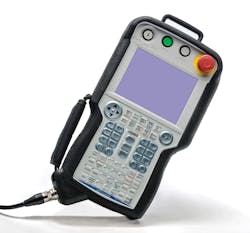A teach pendant (human machine interfaces, or HMIs) is a critical component for any industrial robot. It allows users to program a robot, make changes to tooling, define weld tracking points, facilitate modifications to production routines, and more.
Like any other operation involving a human worker—handling a robotic teach pendant is subject to our own shortfalls and limitations—we drop stuff! It’s in our nature. For example, look at your own cell phone. You are probably looking at a $600 phone that is protected with a $20 case, or perhaps a $60 bumper… or maybe a cracked screen. Now imagine your phone costs thousands of dollars, and has a large cable attached to it.
Workers inadvertently get tangled in the teach pendant’s cabling and pull the pendant from its cradle or work surface. We place pendants on slippery surfaces and they slide to the floor. Crouched under a welding torch to update seam tracking data, we balance ourselves with one hand on the work piece, and the other tethered to the pendant only by a 1-in. strap of Velcro. Once we lose grasp of the pendant and it hits the floor, it’s likely to suffer damage.
As more industrial robots find their way to our manufacturing facilities, it becomes more likely that pendants will suffer damage. Taking a page from your cell phone, pendants need protection. End users and OEMs routinely asked us at Roboworld for solutions to overcome issues with broken teach pendants. One of our first experiments to solve this problem was to sew a protective sleeve for the pendant using technical fabrics and foam inserts to mitigate shock. This approach lacked both elegance and effectiveness. A better solution was needed.
Pendant Armor protection is used for a Motoman DX100 teach pendant.
Our engineers understood that generations of pendants required protection, and we began to laser-scan current (and past) generation models. 3D-printed prototypes of the scans were made, and those areas most prone to damage were identified. Different formulations of materials were then explored to provide the right mix of shock mitigation, chemical compatibility, and ruggedness in modern manufacturing processes. Independent, third-party drop tests confirmed that our custom-molded bumpers mitigated 50% to 70% of the shock when a pendant strikes the ground.
It is important to mull ways to prevent the pendants from getting dropped in the first place. Consider some of the following design features:
- Adding texture to enhancing grip
- Perforations
- Reduces weight
- Wick fluids from the pendant’s grip areas
- Lessen fatigue during prolonged programming sessions
- Non-slip feet
- Protective touchscreen films
Finally, consider the cost. Repairs to broken pendants can cost upwards of $2500 per occurrence, while replacing a pendant can easily exceed $7500 (depending on the OEM manufacturer). Finding a high-quality bumper capable of mitigating those issues cited above could be viewed as insurance for your production line and automation assets. No one can afford to idle a production line to repair a teach pendant.


